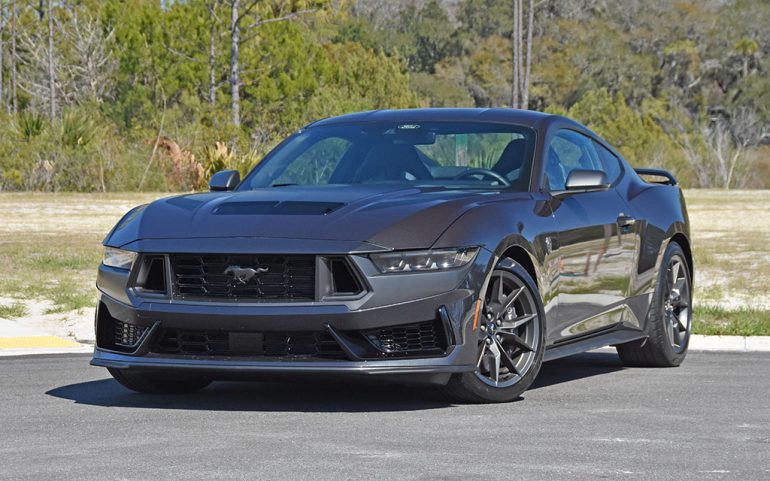
As we approach a world where electric vehicles (EVs) find their proper place in everyday life, Ford keeps hope alive for the purists who refuse to give into the EV way. With that, Ford is left as the only automaker to have a pony car, found in its latest generation Mustang, continuing as one of the few producing a naturally aspirated V8 engine.
The new S650, seventh generation Mustang, embodies the same principles that have kept it as America’s formidable pony car while the demise of the Dodge Challenger/Charger and Chevrolet Camaro places the Mustang on a lone pedestal. For the seventh-generation Mustang, there’s a lot that’s retained in the sensation of driving such a vehicle, in addition to keeping its classic looks. Ford did well with the new Mustang, and this week, I get to experience the Mustang Dark Horse, a top-of-the-line variation that doesn’t necessarily take the place of the Shelby GT350 but does a good job of offering a 5.0-liter V8 sports car that’s poised to run amongst the coveted spaces occupied by sports cars costing much more. Essentially, the Mustang Dark Horse picks up where the outgoing Mustang Mach 1 left off, which is a respected place in the world of affordable sports cars. Its menacing looks and special newfound design character remain highly recognizable but with a fresh new edge.
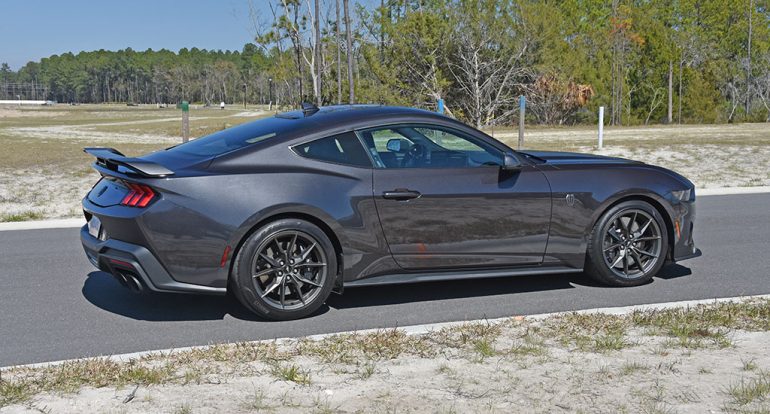
The primary key to a Ford Mustang is giving the masses accessible high performance, which is what you find in the new Mustang Dark Horse, which features the most powerful 5.0-liter V8 yet producing 500 horsepower and 418 lb-ft of torque. That newfound power, which is 20 ponies more than the new Mustang GT and outgoing Mustang Mach 1’s 5.0-liter V8, has a collective of bits to complete a package for the best-performing new-generation Mustang yet. The dual-throttle bodies of the Mustang Dark Horse are part of the unique picture that gives it an edge over any other iteration of the 5.0-liter Coyote V8, in addition to utilizing strengthened internals, such as the forged connecting rods from the GT500.
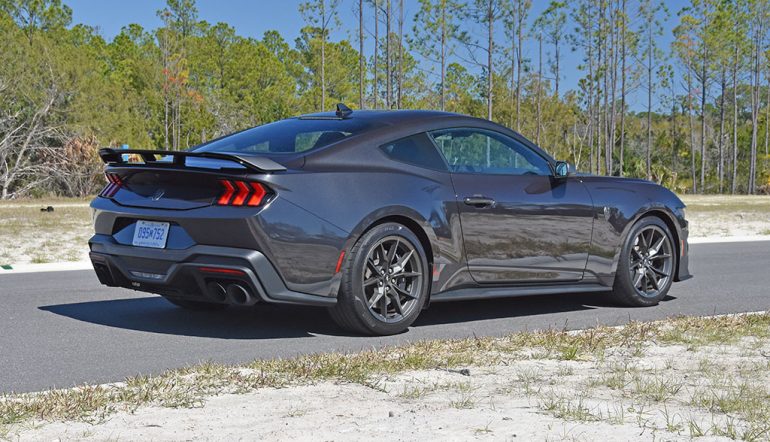
Experiencing this 5.0 is a delight as it’s rev-happy and eager to offer constant power through the rev range up to its 7,500 rpm redline. The Mustang Dark Horse can be had with a 6-speed manual transmission, the welcomed Tremec TR-3160 from the Shelby GT350 and Mach 1, or a snappy-shifting 10-speed automatic. My test vehicle leaves things somewhat endearing with its 10-speed automatic transmission choice, which is surprisingly fun with how it fires off shifts with near-redline power shifts that kick you in your back a bit. The kicks from the 10-speed are aggressive to the point that year may hear barks from the tires, which are, unfortunately, the smaller variation of 19-inch Pirelli P Zero PZ4s 275/40 rears, and 255/40 fronts. Such a size is simply too narrow for my liking, as breaking loose in the rear becomes a common theme. Though, it is fun! To fix such, Ford does offer a $4,995 (recently increased to $5,495) Handling package that equips the Dark Horse with beefer 305/30 fronts and 315/30 rear Pirelli Trofeo RS tires, in addition to revised chassis tuning, adjustable strut top mounts, front towing hooks, and a performance rear spoiler with a Gurney flap.
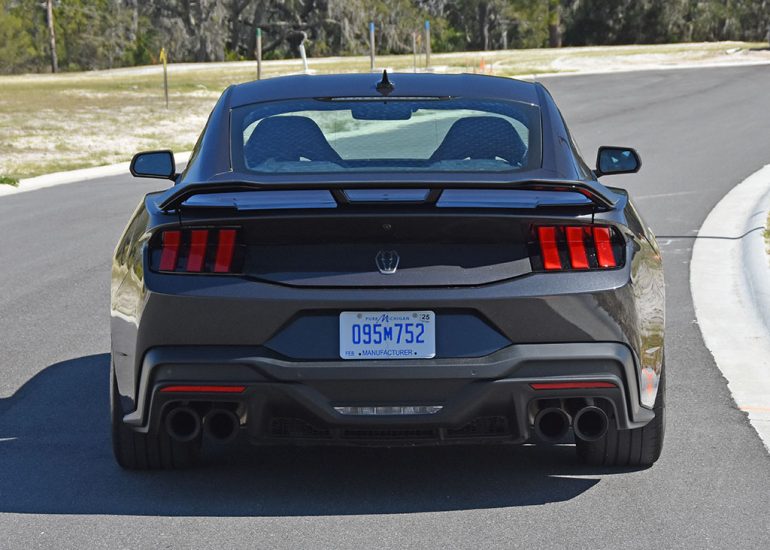
Getting down the brass tacks, the Ford Mustang Dark Horse has excellent dynamics and turns in sharper than I expected, sharper than my very own 2017 Shelby GT350 with its wide 305 tires up front. I would have liked to test out the Dark Horse with the Handling package, but even with the 255 front tire patch, there’s a respected level of assuredness in driving the new Mustang, the best I’ve ever felt in the pony car. Moreover, driving aggressively exhibits a safer plowing into understeer, which can be quickly mitigated with some heavy throttle action to swing the rear out with oversteer. Still, such a trait is surprising in the rear-wheel-drive vehicle with 500 horsepower. Even the braking is assured with massively large Brembo six-piston calipers up front biting down on two-piece rotors (four-piston calipers rear). The brake feel is a lot softer than my Shelby GT350, which I figure is how Ford decided to tune the Dark Horse as a more streetable vehicle versus the track-focused Shelby. The same can be said about many other traits when you compare the Shelby GT350 – in my opinion the Dark Horse feels more suited for canyon carving that track duties.

The overall feel of the Dark Horse is good as well with a surprisingly smooth ride quality through the normal damper setting thanks to the advancement of its magnetic dampers, which has two other modes for Sport and a Track dampening matching the multitude of drive modes. Speaking of drive modes, there’s an interesting layout of the modes that gives you quite the level of customization for the Dark Horse, which includes the settings of Normal, Sport, Slippery, Drag, Track, or a ‘Custom’ MyMode with up to as many as seven customizable programs that you can set to your liking. Those customizable MyMode (Custom) settings allow you to dial in the base drive mode, dampers, steering effort, traction control, and gauge cluster design. There’s almost as much fun customizing your MyMode as hitting 60 mph in 3.7 seconds in the Dark Horse 10-speed auto, which is amazing for a Mustang.
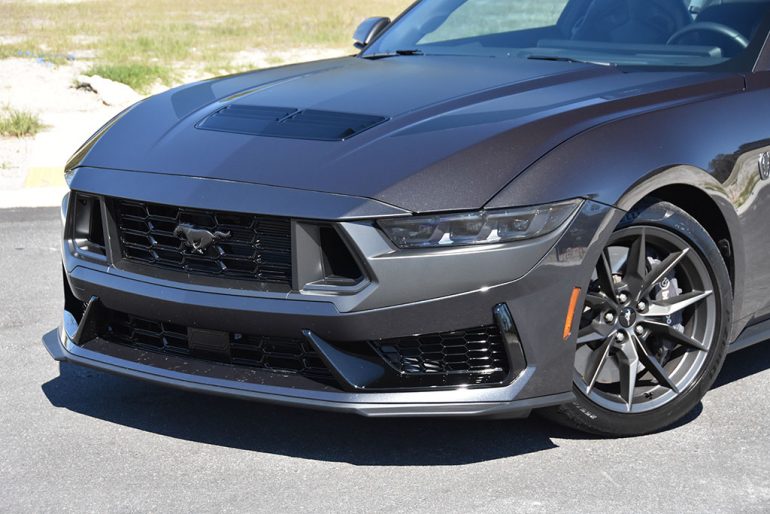
With a big V8 engine, dual throttle bodies, nearly 4,000 pounds to carry around, and 500 horsepower, the new Mustang Dark Horse returns fuel economy numbers that you would expect, getting as much as 22 mpg on the highway, 14 mpg city, and 17 mpg combined. That leaves you with a rather short range of up to 272 miles if you’re careful with a full 12 gallons of premium fuel.
The cabin of the new Mustang doesn’t depart far from the proportions that you find in the previous generation. The four-passenger configuration remains in place with a plentiful amount of front-seat adjustability. In my test car, the seats are the Recaros with micro-suede inserts that are nicely bolstered but not too heavy as you may find in other sports cars with their performance buckets. Unfortunately, there’s no seat heating or ventilation available.
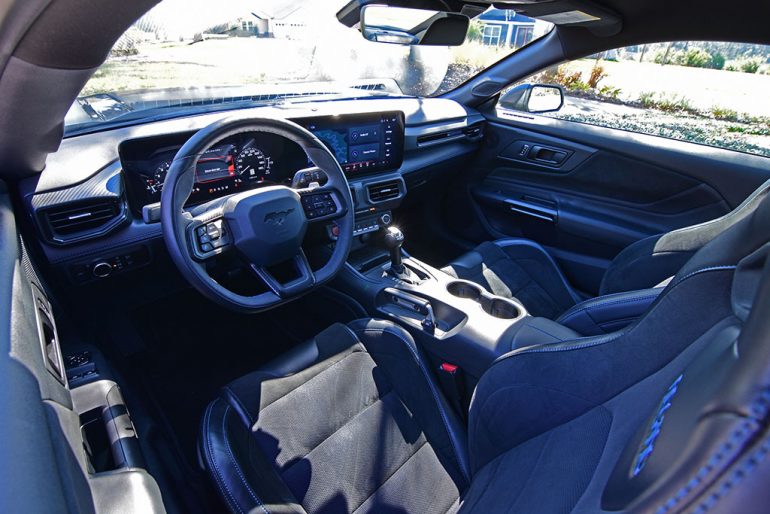
The new dashboard of the seventh-generation Mustang brings a new level of technology to the table with the large 13.2-inch infotainment touchscreen running the new Ford Sync 4 system, which is mostly straightforward in its operation with a relatively short learning curve. The only initial confusing aspect was how some features and controls are separated into two groups by a “Features” option and a separate “Settings” option. You may find yourself entering one of the areas and not finding what you are looking for as it resides in the other function. There’s also a welcoming way of having a split screen to display an additional core feature onscreen. Otherwise, the system is mostly responsive and agreeable if you don’t mind the automatic dual climate controls being onscreen fixed at the bottom of the touchscreen.
There’s also a smartphone wireless charger and the wireless integration (and USB-connected) of Apple CarPlay and Android Auto, which nicely fits into 3/4ths of the screen leaving a split display for other information.
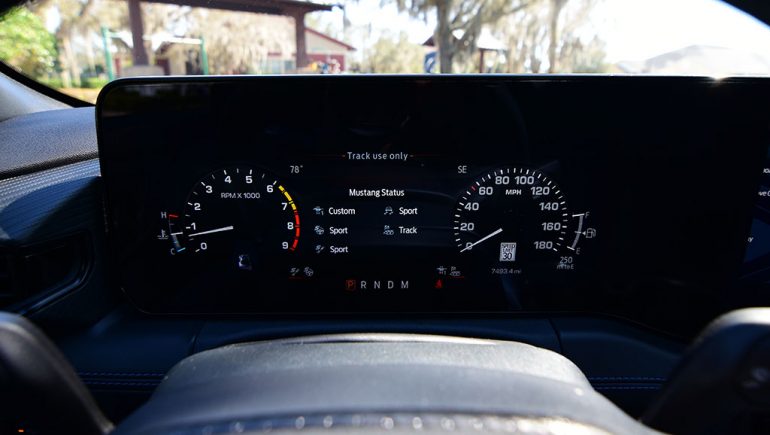
The new 12-inch digital gauge cluster, which nicely flows into the infotainment touchscreen within the same slightly angled glass, is customizable with preset themes, as many as five options, which include the classic-looking 1987-93 Fox Body gauge layout, which turns to the florescent-like green at night to emulate what the Fox Body’s cluster looked like with the lights on.
As far as physical buttons, there are only a handful, in addition to the multitude of steering wheel buttons. Ford was clever to give a couple of physical buttons for a quick-action favorite setting, which comes in handy to set up the exhaust mode if you ever want to make things loud through several sound levels of the exhaust. Not to mention, the exhaust is rather loud in the Track exhaust mode with a slight drone at highway speeds. There’s also the Mustang button to quickly access the drive mode customizations, which comes in handy as well.
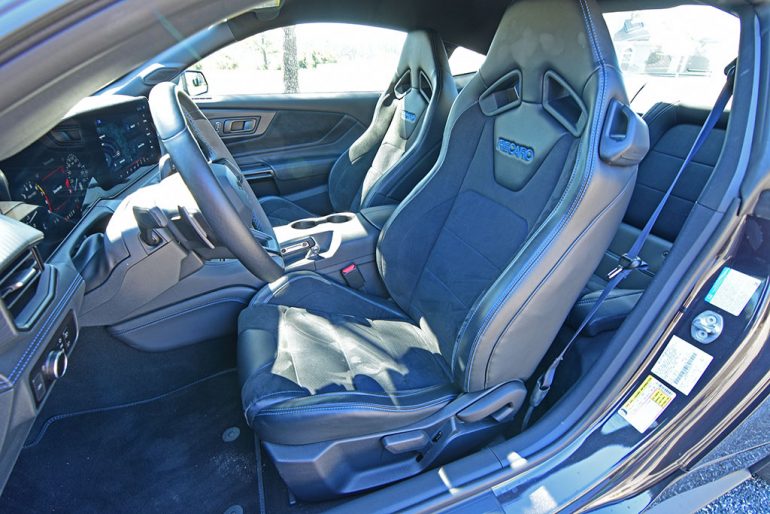
When it comes to fit and finish, the new Mustang is as plush as it has ever been, with a good amount of soft-touch surfaces, accent stitching, and an overall premium feel where there aren’t many areas that feel overly cheap like they did in the past. Even the handbrake, which is a clever electronic lever, is nicely wrapped in leather. The Mustang Dark Horse can easily be driven as a daily vehicle or taken on trips having 13.5 cubic feet of trunk space.
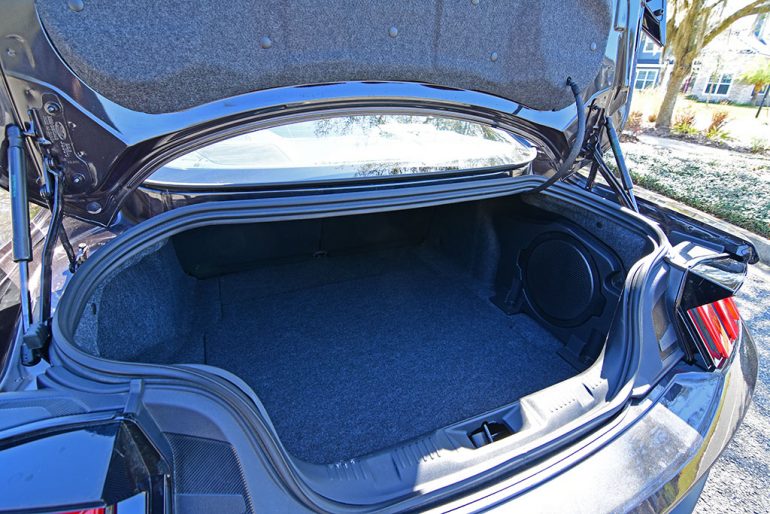
Ford included all of the available active safety features in the Dark Horse Premium within its Ford Co-Pilot 360 Assist+ bundle of features, which highlight blind-spot warning with rear cross-traffic warning, forward collision warning with automatic emergency braking, lane keeping assist, lane centering system, adaptive cruise control, and evasive steering assistance.
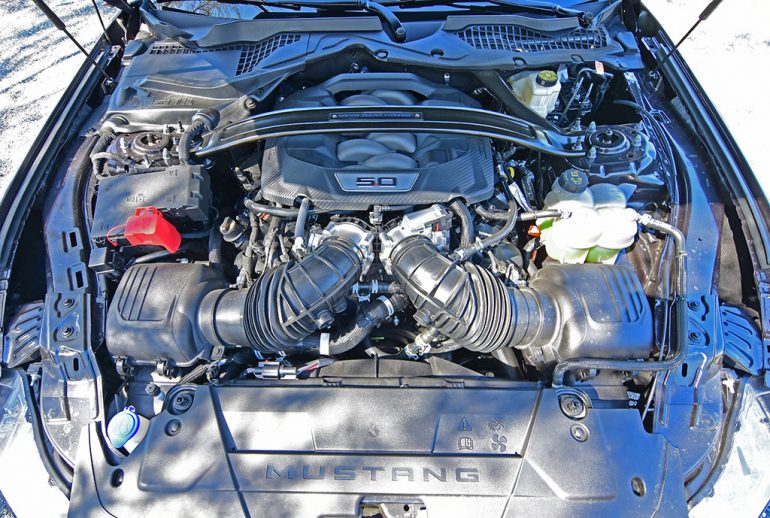
The Ford Mustang has certainly matured over nearly 60 years of its existence, and that maturity, along with its daring performance, runs with some of the best of them. At the baseline for a new Mustang, things are easily attainable for many, with a starting price of just $30,920 for the base EcoBoost. From there, across a myriad of 9 trims, if you include the Convertible models, the Mustang attempts to offer everyone something going as high as my test vehicle’s base price of $62,180. Still, the Ford Mustang is now THE Pony car as it enters a world where it stands alone but competes with vehicles that cost considerably more. Having the Dark Horse trims adds to the appeal and performance, entering the 500-horsepower club with the proper goods to support such performance and style.